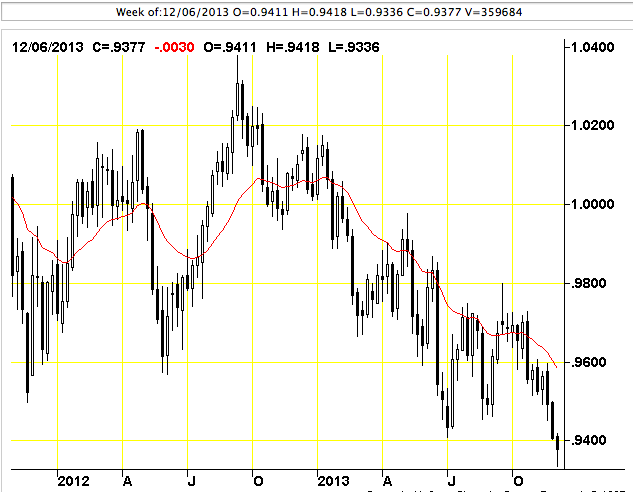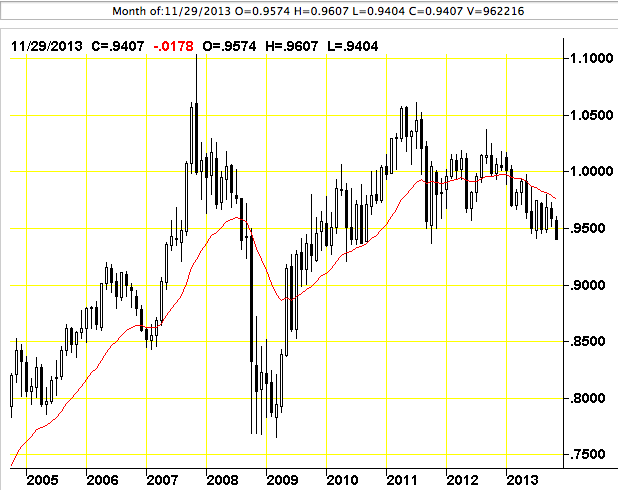Currency
It’s hard to avoid the topic of the beleaguered Canadian dollar given the swift move down we have seen against its US counterpart over the last six weeks. Just six weeks ago the Loonie was much stronger, roughly trading around 97.50 Cents US before the Bank of Canada abandoned what many referred to as their hawkish bias on their second most recent policy announcement. And by removing that reoccurring implication that the next move in interest rates was going to be higher and just simply waiting for the economy to pick up some steam, economist and investors took the withdrawal of that hawkish tone as an indication that next move in interest rates could just as likely be to the downside.

But rest assured, a move lower in interest rates is not in the cards from the Bank of Canada in the months ahead, and the despite the toll its taking on the dollar, we won’t see the bank change step. In fact, this most recent downturn in our currency is one of the most natural trade boosters we could receive. But there is no question that the Canadian economy is struggling to achieve the economic growth forecasts that many had been optimistically hoping for earlier in the year. However, it is still nowhere near sluggish enough for the central bank to re-enter (or arguably remain in) a sustained period of emergency level record low interest rates. And quite simply, it is the inability for the Bank of Canada to raise interest rates due to the inherent weakness in the economy, and that is the main factor driving the Loonie lower.
There are also two fundamental reasons though we are seeing weakness in our currency. The first has to do with the lack of inflation. Most recent data highlights the price level advanced by an annualized rate of a mere seven tenth of a percent in October. And the lack of inflation in the economy has two very simple implications. One is that low inflation levels are associated with more muted periods of economic growth. The second and relating to the lower levels of economic expansion is that the economy struggles to create jobs. But when you have the Canadian economy still averaging over 13,000 jobs created a month, it’s not yet a worry. For any serious credibility given to a downward move in interest rates, job growth would seriously have to dissipate.
The second reason we are seeing the dollar trade lower is to do with a deteriorating balance of trade. Particularly, the weakening demand we are seeing in the resource sector is equating to a waning demand to purchase those commodities. And as that sector of the economy has proven to be so pro cyclical with GDP growth, it can be expected that when the resource sector picks up again, and it will, we will see a renewed demand that is very supportive of the Canadian currency.
While examining the fundamental factors impacting the Canadian dollar these last few months, if these volatile financial markets over the last few years have illustrated anything, fundamentals, albeit important, can very much be trumped by the sentiment of investors. And the fact that Canada was the least dirty shirt among the worlds developed economies was what elevated our Canadian dollar above parity. In fact, beyond the fundamentals, the Canadian dollar almost carried an elite status because of the relative strength of our financial institutions following the worst recession since the Great Depression. In the moment though, the story is very much about the regained strength of the US dollar. Pair that with a central bank abandoning their hawkish views and we will see the premium in our currency dissipate.


In Canada employment continued on a slight upward trend for the third consecutive month, edging up 22,000 in November. The unemployment rate held steady at 6.9% for the third month in a row.
Canadian Dollar Futures traded down 0.50 just after the news release but has since come back to unchanged at 93.83.
Drew Zimmerman
Investment & Commodities/Futures Advisor
604-664-2842 – Direct
604 664 2900 – Main
604 664 2666 – Fax
800 810 7022 – Toll Free

 On the other side of the world today, a couple of gentlemen that few people have ever heard of signed an agreement that has massive consequences for the global financial system.
On the other side of the world today, a couple of gentlemen that few people have ever heard of signed an agreement that has massive consequences for the global financial system.
It was a Memorandum of Understanding signed by representatives of the Singapore Exchange and Hong Kong Exchange. Their aim– to combine their forces in rolling out more financial products denominated in Chinese renminbi.
This is huge.
Hong Kong and Singapore are THE two dominant financial centers in Asia. For years they’ve been locked in competition with one another, much like New York and London. So their public partnership is a very big deal… indicative of the clear objective they have in front of them.
Bottom line– finance executives in Asia see the writing on the wall. They can see that the dollar is in a period of terminal decline, and it’s clear that the Chinese renminbi is going to take tremendous market share away from the dollar. They want a big piece of the action.
The renminbi has already surpassed the euro to become the #2 most-used currency in the world when it comes to trade settlement, according to a report released yesterday by the Society of Worldwide Interbank Financial Telecommunication (SWIFT).
Right now the renminbi has about an 8.6% share of the global market for trade settlement. Granted, the dollar has the lion’s share of trade settlement at more than 80%.
But just look at how quickly the renminbi has grown; in January 2012, its share of the global market was just 1.9%. So it’s grown by nearly a factor of 5x in less than two years.
With today’s agreement between Hong Kong’s and Singapore’s financial exchanges, that growth will likely accelerate.
As we’ve discussed before, the dollar is in a unique position simply because it is the world’s dominant reserve currency.
This means that when a rice distributor in Vietnam does business with a Brazilian merchant, they’ll close the deal by trading US dollars with each other… even though neither nation actually uses the dollar.
It’s been this way since World War II, simply because there has been such a long tradition of trust in the United States, and a steady supply of dollars throughout the world.
But this confidence is fading rapidly as merchants and banks around the world have been seeking alternatives, primarily the Chinese renminbi.
As the dollar’s market share in international trade decreases, it will mean the end of US financial privilege. No longer will the US be able to print money without repercussions.
And as so many other nations have learned the hard way, when you print money with wanton abandon and indebt your nation to the hilt, there are severe consequences to pay.
Today’s move between Hong Kong and Singapore gives us a glimpse into this future.
We’ll soon see more financial products– oil, gold, Fortune 500 corporate bonds, etc. denominated in renminbi and traded in Asia.
And as trade in these renminbi products grows, the dollar will be closer and closer to its reckoning day.
Years from now when this has played out, it’s going to seem so obvious.
Just like the post-Lehman crash in 2008, people will scratch their heads and wonder– ‘why didn’t I see that coming? Why didn’t I recognize that it was a bad idea to loan millions of dollars to unemployed / dead people?’
Duh. Same thing. People will look back in the future and wonder why they didn’t see the dollar collapse coming… why they didn’t recognize that it was a bad idea for the greatest debtor nation in the history of the world to simultaneously control the global reserve currency…
The warning signs are all in front of us. And today’s agreement between Hong Kong and Singapore is one of the strongest signs yet.

 “Success consists of going from failure to failure without loss of enthusiasm.”
“Success consists of going from failure to failure without loss of enthusiasm.”
Winston Churchill
Summary
- Japan’s success is far from certain; it is a catch-22
- If success is predicated on a rising current account surplus, it could spark turmoil elsewhere
- Global turmoil likely means another safe-haven flow back to the yen
As you know, I am big fan of Professor Michael Pettis; he of Beijing University fame. He is an expert on global macro and often shares many out-of-the-box insights. Mr. Pettis seems very concerned about Prime Minister Abe’s chances for success. The odds of failure appear high. Let’s take a look at a few key points.

OTTAWA–After 21 consecutive monthly trade deficits, Canada recorded a small surplus in October as imports declined at a steeper pace than exports, Statistics Canada said Wednesday.
Canada posted a trade surplus in October of 75 million Canadian dollars ($70.4 million), whereas market expectations called for a deficit of C$770 million, according to economists at Royal Bank of Canada. The last time Canada recorded a trade surplus was in December, 2011.
Write to Paul Vieira at paul.vieira@wsj.com












